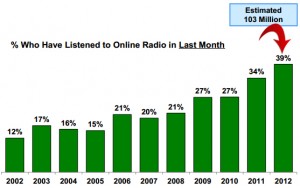The radio industry is experiencing an invasion of digital music services streamed via the Internet.

One advantage Internet radio has going for it is momentum. Pandora’s audience metrics best tell the story.
In March:
Listener hours for Pandora crossed the 1 billion mark, an increase of 88% over the same time period last year. Its share of total U.S. radio listening was 5.79%. More than 125 million people have registered to listen to Pandora’s free personalized radio stations.
With 42% of the population listening to Internet radio, according to a new TargetSpot Study, listening online is no longer a trend, it is a firmly established behavior.
The formula for success of the dominant streaming music services seems fairly straightforward.
Internet radio’s fight plan
1) Cater to the wants of the audience. 2) Get on every device. 3) Work seamlessly with car stereo systems. 4) Make reach ubiquitous. 5) Take ad dollars away from local broadcasters.
It’s Step Five, the implication of head-to-head competition with local radio, that should get the attention of every broadcaster.
A NY Times article lays out the fight scenario: “Pandora’s pitch to advertisers is that its technology can cater to consumers with far greater precision than radio — it can pinpoint listeners by age and sex, ZIP code or even musical taste — and that as it grows, Pandora will effectively be the top station in many cities.”
If Pandora can effectively execute its proposed local advertising model it could be a game changer.
Pandora’s founder and chief strategy officers says “A dollar spent on Pandora is better than a dollar spent on terrestrial radio.” Sounds like a challenge has been issued.
The street fight is on. In the first quarter of 2012, Pandora ran 400 local advertising campaigns across the country. Google, Facebook, Groupon, LivingSocial and others have already been giving many local businesses a taste of the possibilities of accurately geo-targeting ads that create foot traffic.
Competition for local audience and revenue from pure-plays, free standing Internet services, can simply no longer be overlooked.
What can Christian radio stations do to leverage existing platforms and compete in the coming streaming media hyperlocal convergence?
Make the right moves. Here’s five to consider:
1.Study the strategies and tactics of the competition. In “How Pandora Is Winning Over Local Advertisers,” John Hilton, Pandora’s executive director of sales strategy, communication & development, gives a glimpse into what the competition is doing and thinking. “Our key message is that Pandora is working tirelessly to redefine radio,” says Hilton.
2. Stockpile information and ideas on “hyperlocal marketing.” Bookmark Streetfight Magazine, that covers the big new ideas, shifting consumer behavior, and technology-enabled innovations that are promising to build a new world of local advertising and commerce.
3. Make digital multiplatform a priority. The Internet has made every media communications business (and church) a possible television producer, radio broadcaster, blogger and website developer. The world of putting content on a single platform, a website, is gone. A multiplatform strategy publishes content in real time to a website, to mobile apps, and to end users that can become distribution partners.
If needed, partner with a technology provider that will make it easier to jump into the multiplatform world without additional cost or staff. Whatever you do, make sure that your audience can connect with your content when and however they want, or your competitor will.
4. Expand online initiatives, including video content development. Five years ago, CBS Radio CEO Dan Mason said, “In the near future, every radio station can become a TV station.” The future is here.
Christian Web TV platforms are evolving that will enable traditional radio stations to, in addition to their audio channels, include video content, niche and branded content channels. These technology providers and content syndicators will allow broadcasters to innovate with even more compelling, engaging and elaborate ad formats, i.e. video advertising, clickable display ad packages, channel sponsorships, special content packages.
5. Form a hybrid sales team, consisting of digital sellers and traditional radio sales people.
The past is not dead for Christian radio, it is not even gone. It is the foundation on which the committed will fight on the new media landscape by offering audiences and advertisers clearly differentiated and relevant digital content and services.
